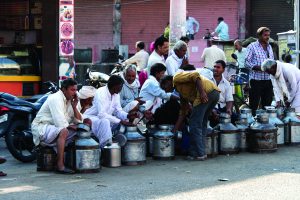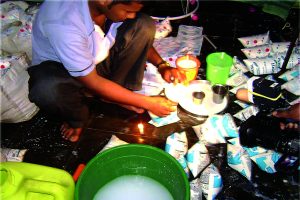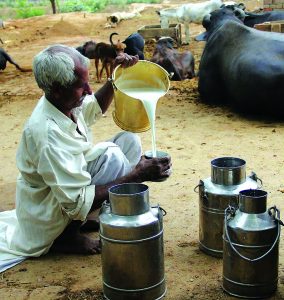 The World Health Organization has given to the Government of India an advisory warning, stating that without adequate tracking of milk adulteration, 87 per cent of citizens could be at risk of developing serious diseases, such as cancer, by the year 2025. The results of investigation expose the dark side of the dairy industry, the adulteration, and the cruelty meted out to the dairy cattle and the unsanitary conditions of milk production.
The World Health Organization has given to the Government of India an advisory warning, stating that without adequate tracking of milk adulteration, 87 per cent of citizens could be at risk of developing serious diseases, such as cancer, by the year 2025. The results of investigation expose the dark side of the dairy industry, the adulteration, and the cruelty meted out to the dairy cattle and the unsanitary conditions of milk production.
The “White Revolution” in India was brought by the launch of “Operation Flood” in 1975, under which the milk production in the country increased from 22 million tonnes in 1970 to current level of 176.3 million tonnes. Currently, India is the largest producer of milk in the world, accounting for 18.5 per cent of world production. But with this has come the greed to adulterate milk caring a fig for its consequences.
Delhi Medical Association (DMA) was approached for comments. Dr. Anil Bansal, former President of DMA said, “milk is a complete food having necessary minerals and vitamins but adulterated milk having urea, detergent, hydro peroxide can lead to deadly diseases including cancer”. Dr. Bansal observed that consumers should avoid use milk procured from unauthorized sources.
FSSAI: 41 per cent samples lacking
 A Food Safety and Standards Authority of India (FSSAI) Survey report released recently covering all Indian States and UTs has shown that about 41 per cent samples, fall short of one or another quality parameter or standard.
A Food Safety and Standards Authority of India (FSSAI) Survey report released recently covering all Indian States and UTs has shown that about 41 per cent samples, fall short of one or another quality parameter or standard.
A total of 6,432 samples of milk were collected from 1,103 towns and cities with population above 50,000. Samples were collected both from the organized (retailers and processors) as well as non-organized (local dairy farms, milk vendors and milk mandis) sectors.
Number of samples collected was linked to population at the sampling locations and covered raw milk as well as various types of processed milk. This is first-of its kind extensive self-designed, representative and most comprehensive survey of safety and quality of liquid milk so far. Earlier, FSSAI had carried out milk surveys in 2011 and 2016 with sample size of 1791 and 1663 respectively.
Even though these surveys were informative, but these were inadequate as no clear picture emerged from these surveys due to small sample size and testing done by different laboratories that did not follow uniform protocol. Moreover, only qualitatively analysis was done and required safety parameters were not covered in the survey.
Use of aflatoxin M1
A major finding in the survey was presence of aflatoxin M1 residues beyond permissible limits. This is the first time that presence of aflatoxin M1 in milk has been assessed. Aflatoxin M1 comes in the milk through feed and fodder, which are currently not regulated in the country. Amongst the top three States with highest levels of aflatoxin M1 residues are Tamil Nadu (88 out of 551 samples), Delhi (38 out of 262 samples) and Kerala (37 out of 187 samples).
This problem is more dominant in processed milk rather the raw milk. The survey further showed that many samples had residues of antibiotics above the permissible limits. Amongst the top three States with highest levels of aflatoxin M1 residues are Madhya Pradesh (23 out of 335 samples), Maharashtra (9 out of 678 samples) and UP (8 out of 729 samples).
The survey has shown that about 41 per cent samples, though safe, fall short of one or another quality parameter or standard. There is non-compliance on account of low fat or low SNF (solids not fat), two key quality parameters both in raw and processed milk. In raw milk, proportion of fat and solids not fat (SNF) varies widely by species and depends on breed as well as quality of feed and fodder.
Cattle must be properly fed and good farm practices must be adopted to improve the amount of fat and SNF in milk. Thus, low fat and SNF for these reasons or due to dilution of milk with water in understood. Non-compliance on account of fat and SNF in standardized and processed milk is however surprising.
The report was finalized after detailed discussions with stakeholders. It was discussed and accepted in a meeting of stakeholders held on September 9, 2019. The survey finds that non-compliance on quality parameters, particularly in processed milk is a matter of concern.
Dr MK Taneja, a well known ENT Specialist said that adulterated milk is at the root of diseases related to lungs prevailing among new born.
Alarming state of cattle
More than the FSSAI report, the data released by the Federation of Indian Animal Protection Organisation (FIAPO) is alarming. It shows that humans who drink milk increase their chances of developing heart disease, diabetes, cancer, and many other ailments. The FIAPO report is titled “CATTLE-OGUE: Unveiling the Truth of the Indian Dairy Industry”.
It is because of the horrifying state of cattle in 451 milk producing centres from India’s 10 leading milk producing states and demands immediate attention by the Centre and State Governments to regulate milk producing dairies. The FIAPO’s investigative report reveals how most cows raised in these dairies are intensively confined, leaving them unable to fulfill their most basic natural needs, such as nursing their calves, and are treated like milk-producing machines, pumped with antibiotics and hormones in order to produce more milk.
While cows suffer in such set-ups, humans who drink their milk increase their chances of developing heart disease, diabetes, cancer, and many other ailments. The unorganized and unregulated upkeep of dairy animals undoubtedly raises a question mark on the safety of the milk that these dairies produce as well as on the sustainability of India’s global leadership of milk production.
Cattle are separated from calves (male calves die within the first week in 25 per cent of dairies), receive little to no veterinary care and are injected with drugs procured illegally to induce sudden milk let-down in almost 50 per cent of the dairies. Unproductive cattle are sold to economically weaker farmers for their personal use or the slaughterhouses by 62.9 per cent dairies — both at low prices to earn meager sums of money from the final disposition.
Jersey, cross breeds and Holstein Friesian variety of cattle have been genetically selected to produce unnatural average output of 20 liters per milking per day per animal! In order to meet the high milk production targets, these animals are over-exploited thereby, resulting in cruel dairy practices. Such practices also reduce the average lifespan of dairy cattle and increase the risk of reproductive diseases and udder infections. The life of a dairy cow lasts for an average of 10 years in a dairy establishment as compared to 25 naturally!
The images of happy cows feeding on green pastures are the perfect façade for a truly cruel and increasingly space-deprived dairy industry. FIAPO’s dairy investigation in 10 states of India reveals the ugly truth behind the “White Revolution” of India, where dairy cattle, especially in urban and peri -urban areas, get little access to soft ground, spend their lives in cramped, poorly ventilated and dark enclosures. Moreover, many dairies were found to have ill, injured and distressed cattle. Poor veterinary care and illegal use of drugs and hormones like oxytocin to increase the milk let-down are prevalent. Multiple wounds were also observed. Thus, an evident delinking of humane treatment of cattle as sentient beings is being noticed as a result of the rising demand for milk and milk products.
This situation persists mainly because all these methods are considered “normal” and best practice in terms of economic gain and cost cutting for profits, by the dairy industry. The report calls for urgent and strict implementation of the existing laws of animal welfare as well as urban governance. It also highlights the need for additional regulation in select areas where there are significant violations of acceptable conditions for dairy animals as well as growing civic problems.
Poor infrastructure
 Poor Infrastructure 25.1 per cent dairies had no arrangements for shelter and had housing in the form of thatch roof sheds, road-side areas, etc. Hard floors cause injuries and bruises to cattle as they slip on such surfaces in their own excreta. About 78.8 per centdairies did not have access to soft ground. About 32.9 per cent dairies did not have proper lighting during the night as a result of which most of the dairies conduct the evening milking in dark enclosures.
Poor Infrastructure 25.1 per cent dairies had no arrangements for shelter and had housing in the form of thatch roof sheds, road-side areas, etc. Hard floors cause injuries and bruises to cattle as they slip on such surfaces in their own excreta. About 78.8 per centdairies did not have access to soft ground. About 32.9 per cent dairies did not have proper lighting during the night as a result of which most of the dairies conduct the evening milking in dark enclosures.
Continuous tethering of cattle at all times was a common practice in 78.8 per cent of the dairies; the tethers are extremely short to accommodate maximum number of cattle in a small area. Tethering means tying an animal with a rope or chain to restrict animal’s movement. This causes extreme physical distress to cattle, preventing them from being in a natural, comfortable posture. The quality and quantity of fodder depends on the economic status of the dairy owner. 57.8 per cent farms feed less than half of the desired minimum quantity (20kg) their cattle per day.
Repeated breeding by means of artificial insemination causes serious reproductive problems to animals and 30- 40 per cent of the total surveyed cattle population, was found to be afflicted by this.
Calves separated from mothers
In 24 per cent dairies the calves were separated from their mothers immediately after birth. These calves are never able to have contact with their mothers. In 25.1 per cent dairies, male calves die within the first month. They are mainly either sold or sent for slaughter if they survive. The old, unproductive cattle also face the same fate with 62.9 per cent dairies selling cattle to smaller farmers or slaughterhouses.
One of the most convenient options for the dairy farmers is also to abandon these “unwanted animals” on the streets. About 57.85 per centd dairies were found to have animals under stress or suffering from injuries or illness. About 55.9 per centdairy owners allow use of sick animals for milking. Injuries ranging from small bruises to tumours and fractures were noticed in 64.1 per cent of dairies.
Use of oxytocin
Illegal use of Oxytocin to increase the milk let down is a common occurrence in 46.9 per cent dairies. Dairy owners use it in excessive quantities (3 to 4 ml.). Under the Drugs and Cosmetics Rules, 1945, Oxytocin is a Schedule-H drug and is required to be supplied on the prescription of a registered medical practitioner only. The formulation of Oxytocin injection is required to be packed in single unit blister packed only to avoid its misuse.
Veterinary care Veterinary care was not provided on regular basis in 84.3 per cent cases. Vaccination schedules are not followed, which leads to outbreak of lethal diseases such a Foot and Mouth Disease (FMD), Hemorrhagic Septicemia (HS) and Black Quarter disease. Vaccinations are mainly avoided to prevent the fall in quantity of milk due to fever induced by the injected vaccine.
The Registration of Cattle Premises Rules, 1978 requires registration of dairies in cities or towns, which have a population exceeding one lakh. This rule is followed almost nowhere. Only 14.3 per cent dairies were registered under the respective Municipal Corporations or the Food Safety and Standards Authority of India (FSSAI).
When contacted, a milk vender who has been supplying milk in the national capital for several years in east Delhi region admitted on record that “I add water a litre of water in 10 litre of milk but never added any residues”. He said that he was not sure whether milk producers used detergents or not.
State-wise issues
 In Uttar Pradesh which is the highest milk producing state of the country with an annual production of 23.33 million tonnes, the survey found that 56 per cent of the dairies had brick and cement flooring. 76 per cent dairies did not provide any form of bedding to the cattle. Tethering Cattle were not allowed to roam free without tethers in 74 per cent dairies.
In Uttar Pradesh which is the highest milk producing state of the country with an annual production of 23.33 million tonnes, the survey found that 56 per cent of the dairies had brick and cement flooring. 76 per cent dairies did not provide any form of bedding to the cattle. Tethering Cattle were not allowed to roam free without tethers in 74 per cent dairies.
About 22 per cent dairies use oxytocin during milking. 50 per cent dairies do not allow the calves to wean off naturally till the mother allows suckling (6 to 7 months of age). About 92 per cent dairies did not have a regular visiting veterinarian. About 18 per cent dairies did not have any surviving male calf while 24 per cent dairies sold the calves for slaughter. About 70 per cent dairies “discarded” older, unproductive cattle while 28 per cent dairies sold their cattle for slaughter. About 48 per cent dairies continuously used ill animals for milking.
Rajasthan is the second largest dairy producer of the country aiming to surpass Uttar Pradesh. Even here 51.06 per cent dairies had brick and cement flooring. None of the dairies provided bedding to the cattle. About 14.3 per cent dairies used oxytocin while milking. About 87.2 per cent dairies tied their cattle on a short tether.
There was male calf abuse as 42.9 per cent dairies did not have even a single surviving male calf while more than 50 per cent dairies sold male calves for slaughter. About 40.8 per cent dairies used ill and injured animals for milking. As many as 98 per cent dairies lacked proper lighting facilities, while none had adequate resting space for cattle.
Telangana, is a major milk producer in South India, contributing 9.6 per cent to the total milk production of the country with an output of 12.76 million tonnes. Even this state was found poor in dairy practices as 88.9 per cent dairies had a mix of cement and bricks as flooring. About 82.2 per cent dairies had animals were tethered at all times. As many as 53.3 per cent dairies used oxytocin and 93.3 per cent dairies did not have a regular visiting veterinarian.
About 73.3 per cent dairies either sold male calves to smaller farmers or for slaughter while 64.5 per cent dairies used ill and injured animals for milking. Then 82.2 per cent dairies had no proper provision for lighting and 86.6 per cent dairies had inadequate resting place. Also 70 per cent dairies sell old cattle to farmers or for slaughter.
Gujarat contributes 10.3 million tonnes of milk to the total national output and is the land of Amul, the iconic milk cooperative. Several local dairy schemes are being run by various cooperatives and institutions such as the National Dairy Development Board (NDDB), Intensive Cattle Development Program (ICDP), Bhartiya Agro Industries Foundation (BAIF) to name a few- to encourage people to take up dairy as a profitable business while addressing to all issues that might arise in this sector.
Even here, 68.1 per cent dairies had cement and brick flooring and 85.1 per cent dairies kept the animals tied on short tethers with no space to rest with ease. About 34.1 per cent dairies used oxytocin. Even in Gujarat, 72.34 per cent dairies used sick animals for milking.
In Punjab, the agrarian bowl of the country pitches in with 7.3 per cent of the total milk production of the country, undergoing a ‘milk revolution’ of its own, similar problems persist. More than 90 per cent dairies had cement and brick flooring and 76 per cent dairies did not provide any form of bedding to cattle. Over 72 per cent dairies had animals on tethers and 52 per cent dairies indiscriminately used oxytocin. Close to 92 per cent dairies depended on the local government veterinary officials for treatment of cattle while 58 per cent dairies let male calves die due to neglect and abandonment.
Madhya Pradesh produces 8.8 million tonnes of milk to land at the 6 place nationally as far as milk production is concerned. Known for its Nimari and Deoni cow breeds, the local cooperatives and the animal husbandry department are coming up with the agenda of reaching out to more people to take up dairying with better and efficient facilities for them to do business.
However, 59.5 per cent dairies had brick and cement flooring and 59.5 per cent dairies were always tied. About 50 per cent dairies used oxytocin while milking the animals. About 38.1 per cent dairies sold their cattle to farmers or for slaughter and 35.7 per cent dairies left their old animals as stray. About 50 per cent dairies used ill animals for milking.
Similar situation prevailed in Maharashtra which contributes by 6.5 per cent to the total milk share of the country. The Navinypuarn scheme was launched with the aim of increasing the productivity of milch cattle along with improving the existing 13 dairy machinery of the state.
About 51.4 per cent dairies had flooring made up of either only bricks or only cement or a mix of the two. The cattle were kept tied at all times in 100 per cent of the dairies. The use of oxytocin was prevalent as 48.6 per cent dairies used oxytocin. Male calves were either left stray or sold for slaughter in 74.3 per cent dairies and old cattle were sold either to smaller farmers or for slaughter in 60 per cent dairies and 51.4 per cent dairies used ill animals for milking.
Haryana state holds a special place in the field of milk production and it is known as the ‘Milk Pail’ of the country, producing 7.04 million tonnes of milk in 2014-15. Over 80 per cent of the state’s milk comes from buffaloes alone. It is famous for its ‘Murrah’ breed of buffalo. The current focus of the state government 14 is to conserve and develop its indigenous cattle through various schemes.
In this state, 64.6 per cent dairies had only brick and cement flooring and 58.3 per cent dairies did not leave cattle free of tethers. Use of oxytocin was quite in vogue as 43.8 per cent dairies used oxytocin on cattle. About 91.66 per cent dairies had no regular veterinarian to check for diseases and 60.42 per cent dairies sold their old, unproductive cattle to low end farmers or sent them for slaughter and 58.3 per cent dairies used sick, injured or diseased cattle for milking.
Tamil Nadu is one of the leaders in milk production with an output of 145.88 lakh litres per day. The Tamil Nadu Co- operative Milk Producers’ Federation Limited was started in 1981 on the lines of the Gujarat 15 model and is popularly known as ‘Aavin’. Various schemes to encourage marginal farmers to take up 16 dairying have been introduced by the state government since 2011. Even here, 65.6 per cent dairies had cement and brick flooring and 74.3 per cent dairies always kept their cattle on tethers. Oxytocin use was observed in 60 per cent dairies.
The National Capital Territory of Delhi contributes 2 per cent to the total dairy production of the country through the vast expanses of dairies flourishing around its peripheries. Areas like Vasant Kunj and Ghaziabad have approximately 100 dairies holding 15,000 cattle in one area. Sadly there is little administrative support for the dairy owners who establish dairies in areas. These are often surrounded by garbage dumping sites, sewage lines and illegal slaughter shops. Flooring Material 90 per cent dairies had flooring made of bricks and cement. Cattle were mostly tied all the time. Shockingly, 100 per cent dairies used oxytocin on cattle. Almost 100 per cent dairies did not have any male calf older than 2 months. They were either left to die or sold for slaughter.
Rising demand, more challenges
 India is the largest producer of milk in the world since 1997, but in the year 2014, for the first time, it beat the entire European Union. On a country basis, after India, the US produces the most milk, and China comes in third. Our per capita availability of milk is over 300 grams per day, which is more than the world average of 294 grams per day.
India is the largest producer of milk in the world since 1997, but in the year 2014, for the first time, it beat the entire European Union. On a country basis, after India, the US produces the most milk, and China comes in third. Our per capita availability of milk is over 300 grams per day, which is more than the world average of 294 grams per day.
However, spurred by rising incomes, a growing population and changing food preferences, the demand for milk and milk products will grow to at least 210 million tonnes by 2021–22, a rise of 36 per cent over five years, according to government estimates. To boost milk yield, India would need to generate 1,764 million tonnes of fodder by 2020, according to an India Spend analysis of government data. But existing sources can only manage about 900 million tonnes of fodder–a shortage of 49 per cent.
The availability and quality of fodder has a direct bearing on the quantity and quality of milk productivity, the data show. All the three states that topped milk productivity in terms of gram per day–Rajasthan (704), Haryana (877) and Punjab (1,032)–had earmarked more than 10 per cent of their cultivable land for pastures, according to the 2015 SOIL report. The national average is 337.
Stringent laws proposed
In the meanwhile, those adulterating food products could face life imprisonment and penalty of up to 10 lakh as per the amendments proposed by the Food Safety and Standards Authority of India (FSSAI) has recommended stringent punishment to curb food adulteration following the Supreme Court order. The regulator has asked all its state and union territories enforcement divisions to strengthen checks on milk producers to ensure they are complying with the Food Safety and Standards Act.
Readers are invited to send their personal experiences & suggestions related to contaminated drinking milk
letters@tehelka.com













